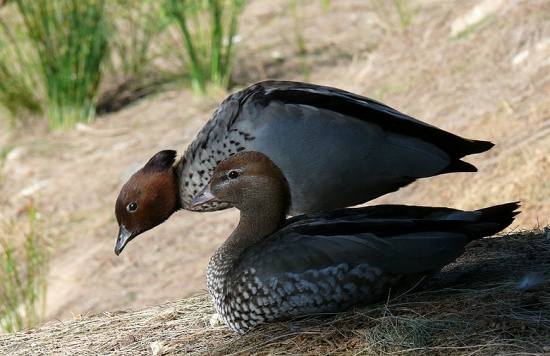| Line 3: | Line 3: | ||
[[Image:AussiWoodDuck.jpg|thumb|550px|right|Photo by Rose Fletcher <br/> Photographed: Adelaide, [[South Australia]].]] | [[Image:AussiWoodDuck.jpg|thumb|550px|right|Photo by Rose Fletcher <br/> Photographed: Adelaide, [[South Australia]].]] | ||
==Identification== | ==Identification== | ||
| − | 45-51 cm. Grey, dark brown head and mottled breast. Female has white stripes above and below the eye and mottled underparts. Both sexes have grey wings with black primaries and a white speculum. | + | 45-51 cm. Grey, dark brown head and mottled breast. Male has a black "mane" at the back of the head that is not always erect, and thus missed. Female has white stripes above and below the eye and mottled underparts. Both sexes have grey wings with black primaries and a white speculum. |
==Distribution== | ==Distribution== | ||
| Line 14: | Line 14: | ||
It nests in a tree hole laying 8-12 eggs. | It nests in a tree hole laying 8-12 eggs. | ||
| − | It feeds mostly by grazing | + | It feeds mostly by grazing, but also dabbles and up-ends in shallow water, feeding on aquatic plants. |
| − | |||
| − | |||
Revision as of 22:26, 5 July 2009
Alternative Name: Australian Wood Duck.
- Chenonetta jubata
Identification
45-51 cm. Grey, dark brown head and mottled breast. Male has a black "mane" at the back of the head that is not always erect, and thus missed. Female has white stripes above and below the eye and mottled underparts. Both sexes have grey wings with black primaries and a white speculum.
Distribution
Taxonomy
It is the only living species in the genus Chenonetta. Traditionally placed in the Anatinae (dabbling duck) subfamily, it might actually belong to the Tadorninae (shelduck) subfamily (Sraml et al. 1996); possibly, the Ringed Teal is its closest living relative (Johnson & Sorenson 1999).
Habitat
Lightly wooded swamps and marshes.
Behaviour
It nests in a tree hole laying 8-12 eggs.
It feeds mostly by grazing, but also dabbles and up-ends in shallow water, feeding on aquatic plants.




